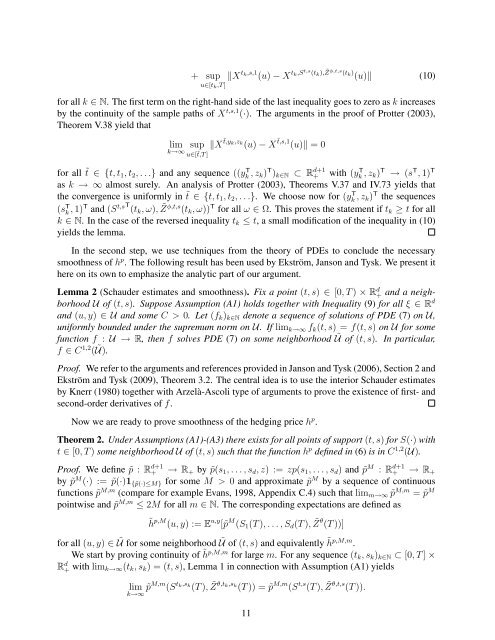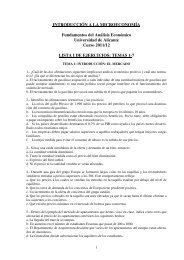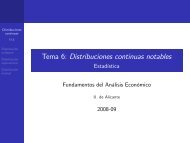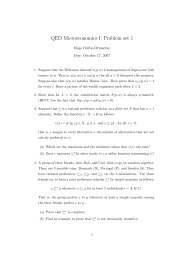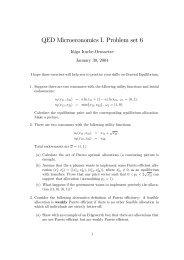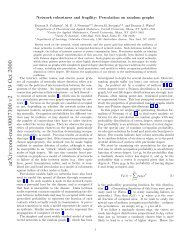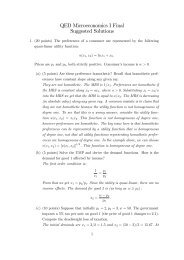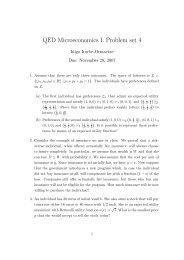Hedging under arbitrage
Hedging under arbitrage
Hedging under arbitrage
Create successful ePaper yourself
Turn your PDF publications into a flip-book with our unique Google optimized e-Paper software.
+ sup<br />
u∈[tk,T ]<br />
�X tk,s,1 tk,S<br />
(u) − X t,s (tk), ˜ Zφ,t,s (tk)<br />
(u)� (10)<br />
for all k ∈ N. The first term on the right-hand side of the last inequality goes to zero as k increases<br />
by the continuity of the sample paths of X t,s,1 (·). The arguments in the proof of Protter (2003),<br />
Theorem V.38 yield that<br />
lim<br />
k→∞ sup �X<br />
u∈[˜t,T ]<br />
˜t,yk,zk ˜t,s,1<br />
(u) − X (u)� = 0<br />
for all ˜t ∈ {t, t1, t2, . . .} and any sequence ((y T k , zk) T )k∈N ⊂ R d+1<br />
+ with (y T k , zk) T → (s T , 1) T<br />
as k → ∞ almost surely. An analysis of Protter (2003), Theorems V.37 and IV.73 yields that<br />
the convergence is uniformly in ˜t ∈ {t, t1, t2, . . .}. We choose now for (y T k , zk) T the sequences<br />
(s T k , 1)T and (S t,sT (tk, ω), ˜ Z φ,t,s (tk, ω)) T for all ω ∈ Ω. This proves the statement if tk ≥ t for all<br />
k ∈ N. In the case of the reversed inequality tk ≤ t, a small modification of the inequality in (10)<br />
yields the lemma.<br />
In the second step, we use techniques from the theory of PDEs to conclude the necessary<br />
smoothness of h p . The following result has been used by Ekström, Janson and Tysk. We present it<br />
here on its own to emphasize the analytic part of our argument.<br />
Lemma 2 (Schauder estimates and smoothness). Fix a point (t, s) ∈ [0, T ) × Rd + and a neighborhood<br />
U of (t, s). Suppose Assumption (A1) holds together with Inequality (9) for all ξ ∈ Rd and (u, y) ∈ U and some C > 0. Let (fk)k∈N denote a sequence of solutions of PDE (7) on U,<br />
uniformly bounded <strong>under</strong> the supremum norm on U. If limk→∞ fk(t, s) = f(t, s) on U for some<br />
function f : U → R, then f solves PDE (7) on some neighborhood Ũ of (t, s). In particular,<br />
f ∈ C1,2 ( Ũ).<br />
Proof. We refer to the arguments and references provided in Janson and Tysk (2006), Section 2 and<br />
Ekström and Tysk (2009), Theorem 3.2. The central idea is to use the interior Schauder estimates<br />
by Knerr (1980) together with Arzelà-Ascoli type of arguments to prove the existence of first- and<br />
second-order derivatives of f.<br />
Now we are ready to prove smoothness of the hedging price h p .<br />
Theorem 2. Under Assumptions (A1)-(A3) there exists for all points of support (t, s) for S(·) with<br />
t ∈ [0, T ) some neighborhood U of (t, s) such that the function h p defined in (6) is in C 1,2 (U).<br />
Proof. We define ˜p : R d+1<br />
+ → R+ by ˜p(s1, . . . , sd, z) := zp(s1, . . . , sd) and ˜p M : R d+1<br />
+ → R+<br />
by ˜p M (·) := ˜p(·)1{˜p(·)≤M} for some M > 0 and approximate ˜p M by a sequence of continuous<br />
functions ˜p M,m (compare for example Evans, 1998, Appendix C.4) such that limm→∞ ˜p M,m = ˜p M<br />
pointwise and ˜p M,m ≤ 2M for all m ∈ N. The corresponding expectations are defined as<br />
˜h p,M (u, y) := E u,y [˜p M (S1(T ), . . . , Sd(T ), ˜ Z θ (T ))]<br />
for all (u, y) ∈ Ũ for some neighborhood Ũ of (t, s) and equivalently ˜ h p,M,m .<br />
We start by proving continuity of ˜ h p,M,m for large m. For any sequence (tk, sk)k∈N ⊂ [0, T ] ×<br />
R d + with limk→∞(tk, sk) = (t, s), Lemma 1 in connection with Assumption (A1) yields<br />
lim<br />
k→∞ ˜pM,m (S tk,sk (T ), Z˜ θ,tk,sk M,m t,s<br />
(T )) = ˜p (S (T ), Z˜ θ,t,s<br />
(T )).<br />
11


